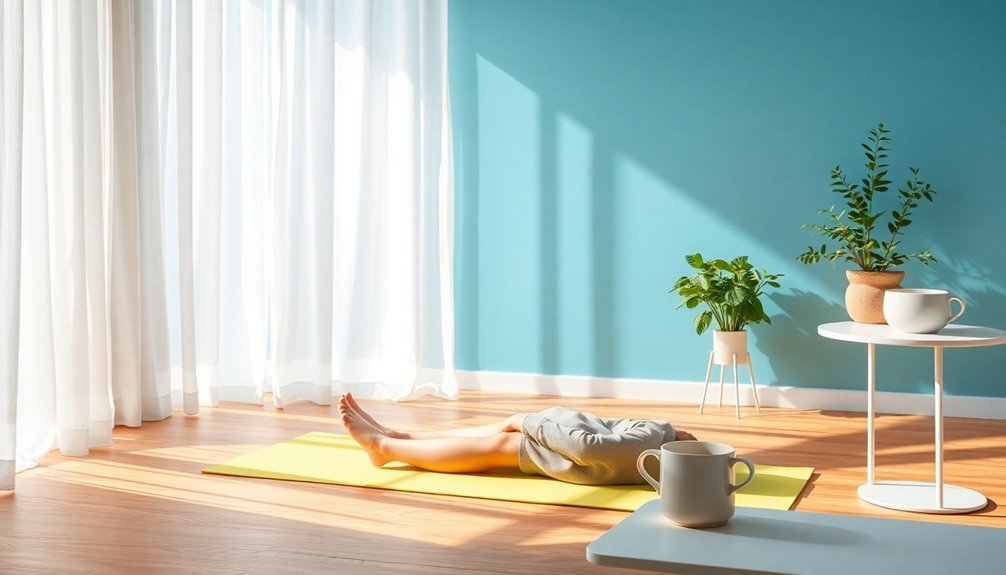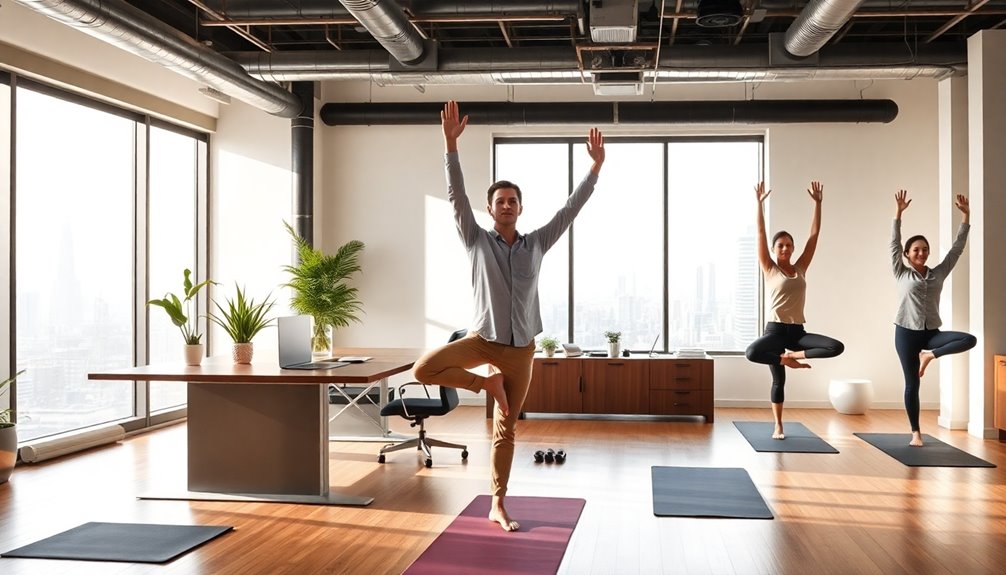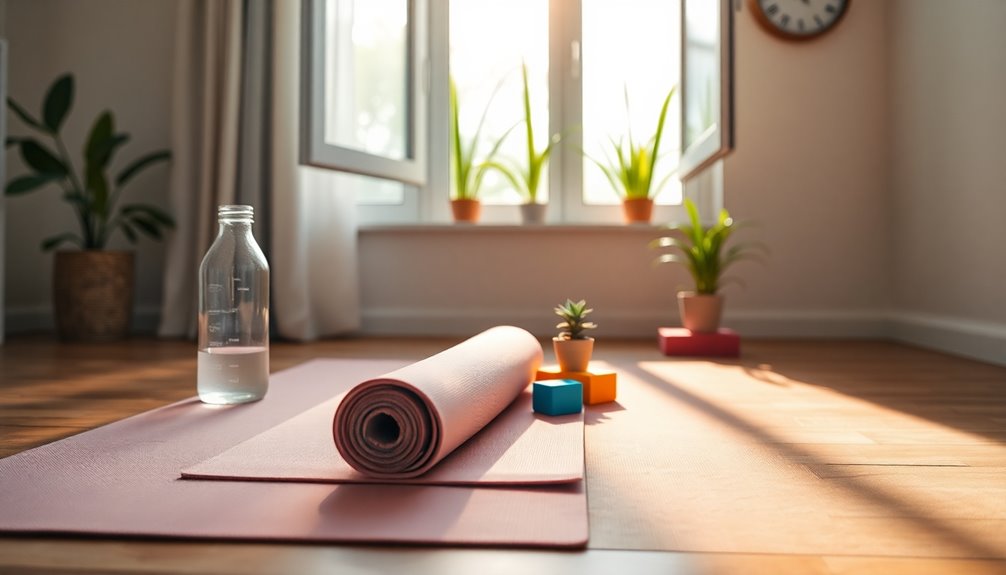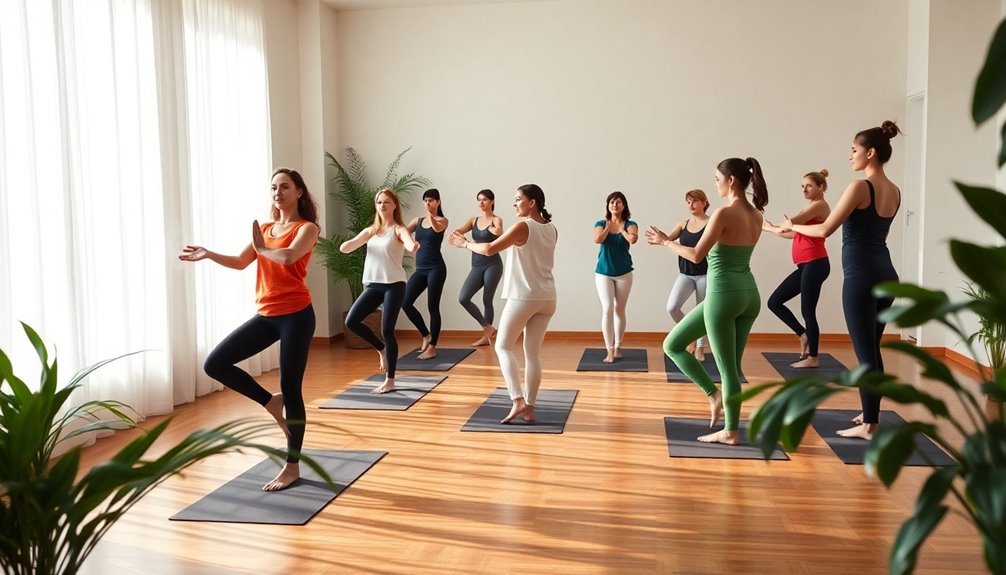Fifteen-minute yoga routines are a fantastic way to kickstart your practice as a beginner. These short sessions can improve your flexibility, boost your mood, and reduce stress. You might try morning energizers, like Sun Salutations and Warrior I, or unwind in the evening with Child's Pose and Savasana. Essential props like a yoga mat and blocks can enhance your comfort and safety. Plus, incorporating mindful breathing techniques can deepen your experience. With these quick routines, you can easily fit yoga into your day. Keep going, and you'll discover even more ways to enrich your practice and well-being.
Key Takeaways
- A 15-minute beginner routine can include basic poses like Mountain, Downward Dog, and Child's Pose for grounding and relaxation.
- Start with gentle warm-ups such as Cat-Cow stretches to prepare the body for deeper stretches and movements.
- Incorporate breathing techniques like Ujjayi breath to enhance focus and calmness throughout the practice.
- Focus on maintaining proper alignment and using props like blocks or straps for support and comfort.
- End with Savasana (Corpse pose) for deep relaxation and mental clarity, allowing the body to absorb the benefits of the practice.
Benefits of 15-Minute Yoga

If you're looking to incorporate yoga into your daily routine, a quick 15-minute session can offer remarkable benefits. You don't need hours of spare time to experience the positive effects of yoga. In just a quarter of an hour, you can deepen your mind-body connection, enhancing your awareness of how your body feels and moves. This practice helps you tune into your physical and emotional states, fostering a sense of unity that can be incredibly grounding.
One of the most immediate benefits of a short yoga session is stress relief. As you step onto your mat, you allow yourself to breathe deeply and focus on the present moment, leaving the chaos of daily life behind. Simple poses combined with mindful breathing can notably reduce tension, both physically and mentally.
You might find that releasing pent-up stress during these few minutes creates a ripple effect, helping you approach challenges with a calmer mindset throughout your day. Additionally, incorporating anti-inflammatory foods into your diet can further enhance your overall wellness and complement your yoga practice.
Furthermore, this brief practice can be a welcome break, giving you space to recharge. Whether you're at home, in the office, or even in a park, you can easily find a spot to roll out your mat and enjoy some peace. Remember, every little bit counts, and committing just 15 minutes to yoga can lead to lasting changes in your well-being.
Essential Yoga Props

Incorporating yoga into your routine is even more effective when you have the right tools at your disposal. Yoga props can enhance your practice, offering support and stability as you learn new poses. They help you feel more comfortable and confident, making your sessions enjoyable and rewarding. Here are some essential yoga props to contemplate:
- Yoga Mat: A non-slip surface brings safety and comfort to your practice.
- Blocks: These help you modify poses, making them accessible and less intimidating.
- Straps: Ideal for improving flexibility, straps allow you to hold poses longer without strain.
- Bolsters: Perfect for restorative practices, bolsters provide gentle support and help you relax.
Integrating yoga props can also enhance your experience similar to how mini bands offer unique challenges for effective muscle toning. If you're new to yoga or on a budget, don't worry! There are plenty of prop alternatives that can work just as well. For instance, you can use a thick towel instead of a yoga mat, or a sturdy book in place of blocks. Household items often serve as effective budget options that keep your practice accessible and enjoyable.
Morning Routine for Energy

Starting your day with a focused morning yoga routine can boost your energy levels and set a positive tone for the rest of the day. By incorporating sunrise stretches and energizing poses, you'll awaken your body and mind, making you feel revitalized and ready to tackle whatever comes your way. Engaging in practices like yoga can also complement techniques from the Brainwave Guidance Program to enhance your overall well-being.
Here's a simple table to guide you through a quick morning routine:
| Pose | Duration |
|---|---|
| Cat-Cow Stretch | 1 minute |
| Downward Dog | 1 minute |
| Sun Salutations | 2 minutes |
| Warrior I | 1 minute each side |
| Tree Pose | 1 minute each side |
Begin with the Cat-Cow stretch to gently warm up your spine. Progress into Downward Dog, focusing on your breath to deepen the stretch. Next, flow through a few Sun Salutations, linking movement with breath to energize your entire body. Following that, practice Warrior I to build strength and confidence, holding it on each side. Finally, balance in Tree Pose, which not only enhances focus but also grounds you for the day ahead.
Evening Routine for Relaxation

As the day winds down, dedicating time to an evening yoga routine can help you unwind and prepare for a restful night. This practice not only promotes relaxation but also encourages deep breathing, which is essential for stress relief. By focusing on calming poses, you can release the tension built up throughout your day and foster a sense of peace before bedtime. Additionally, incorporating mindfulness meditation into your routine can enhance your overall relaxation experience.
Here's a simple evening routine you can try:
- Child's Pose: Kneel on the floor, sit back on your heels, and stretch your arms forward. This pose helps to calm the mind and relieve tension in the back.
- Seated Forward Bend: Sit with your legs extended and reach for your toes. This gentle stretch promotes relaxation while calming your nervous system.
- Reclining Bound Angle Pose: Lie on your back, bring the soles of your feet together, and let your knees fall to the sides. This position opens the hips and encourages deep breathing.
- Savasana (Corpse Pose): Lie flat on your back, arms at your sides, and close your eyes. This pose allows your body to absorb the benefits of your practice, providing deep relaxation.
Office Yoga Breaks

Taking just a few minutes for office yoga breaks can greatly enhance your productivity and overall well-being throughout the workday. You don't need to leave your desk to reap the benefits; simple chair poses and desk stretches can do wonders for your body and mind.
Start with a chair pose: sit up tall in your chair, feet flat on the floor. Raise your arms overhead and take a deep breath in, feeling your spine lengthen. Hold for a few moments, and then release, allowing your shoulders to relax. This pose helps to alleviate tension in your back and opens up your chest, making you feel more energized.
Next, try some desk stretches. Stand up and place your hands on your desk, then step back and gently lean into the stretch. Feel the release in your shoulders and lower back.
You can also do wrist and neck stretches while seated. Simply extend one arm out, palm up, and gently pull back on your fingers with the other hand. Look side to side to relieve neck tension.
Incorporating these short yoga breaks into your day can improve focus and reduce stress. You're not only investing in your health but creating a supportive environment for yourself and your colleagues. So, take a moment to pause, breathe, and stretch. Your body and mind will thank you, and you'll foster a sense of belonging in your workplace by encouraging others to join in.
Tips for Consistent Practice

To maintain a consistent yoga practice, setting realistic goals and establishing a routine that seamlessly fits into your daily life is essential. You want to make yoga a part of your self-care routine, and that starts with finding a time and place that work for you. Here are some tips to help you build discipline and stay motivated:
- Choose a specific time: Pick a time of day that you can dedicate to your practice, whether it's morning, lunch breaks, or evening. Consistency helps reinforce your routine.
- Create a designated space: Find a quiet, comfortable area in your home or office where you can roll out your mat. This space should feel inviting and inspiring.
- Start small: Begin with just a few minutes each day. Whether it's five minutes or ten, gradually increasing your practice will help you build discipline without feeling overwhelmed.
- Join a community: Connecting with others who share your interest in yoga can provide a sense of belonging. Consider joining a local class or an online group for support and encouragement.
- Incorporating mindfulness into your practice can enhance your overall well-being, making it a vital part of your self-care routine.
Frequently Asked Questions
Can I Do Yoga if I'm Pregnant?
Absolutely, you can practice yoga while pregnant! Just remember to take safety precautions. Focus on modified poses that suit your changing body and avoid any positions that cause discomfort. Listening to your body is key; if something doesn't feel right, adjust or skip it altogether. Joining a class specifically for pregnant women can also help you feel supported and connected. Embrace this journey, and enjoy the benefits of yoga during this special time!
What if I Have a Previous Injury?
If you have a previous injury, it's important to listen to your body and take care of yourself. You can practice modified poses and gentle stretches that accommodate your needs. Focus on what feels good, avoiding any movements that cause pain.
Always consult with a healthcare professional before starting a routine, and remember, you're not alone in this journey. Many find yoga to be a supportive practice that can help in healing and recovery.
How Often Should I Practice Yoga Weekly?
You might find it surprising that practicing yoga just three to five times a week can greatly enhance your well-being. Frequency recommendations suggest consistency for maximum benefits, like increased flexibility and reduced stress.
To stay motivated, set achievable goals and celebrate small victories. As you progress, listen to your body and adjust your routine. Remember, it's about finding what fits you best, so embrace each session as a step toward greater balance and connection.
Are There Any Age Restrictions for Beginners?
There aren't any age restrictions for beginners in yoga! Whether you're a youth keen to participate or an elderly individual seeking modifications, yoga welcomes everyone. It's all about finding what works for you.
As a beginner, focus on your comfort and gradually explore poses that suit your body. Remember, yoga's a journey, and each step counts. Embrace the practice, connect with others, and enjoy the benefits at any age!
Can Yoga Help With Weight Loss?
Yoga's wonderful world can indeed aid you in your weight loss journey. By fostering a strong mind-body connection, you'll enhance your awareness of physical sensations and cravings. Plus, it's a fantastic tool for stress management, helping you tackle emotional eating.
With regular practice, you'll not only burn calories but also cultivate a sense of community and belonging. Embrace the process, and you'll find that yoga can transform both your body and your mindset!
Conclusion
In just 15 minutes, you can transform your day with uplifting yoga routines tailored for beginners. Whether you're seeking morning motivation, evening ease, or a quick office escape, these practices promise to enhance your energy and elevate your well-being. Remember, consistency is key! So, grab your props, carve out your time, and commit to this calming journey. With dedication, you'll discover the delightful difference yoga can make in your daily life. Start today and savor the serenity!



